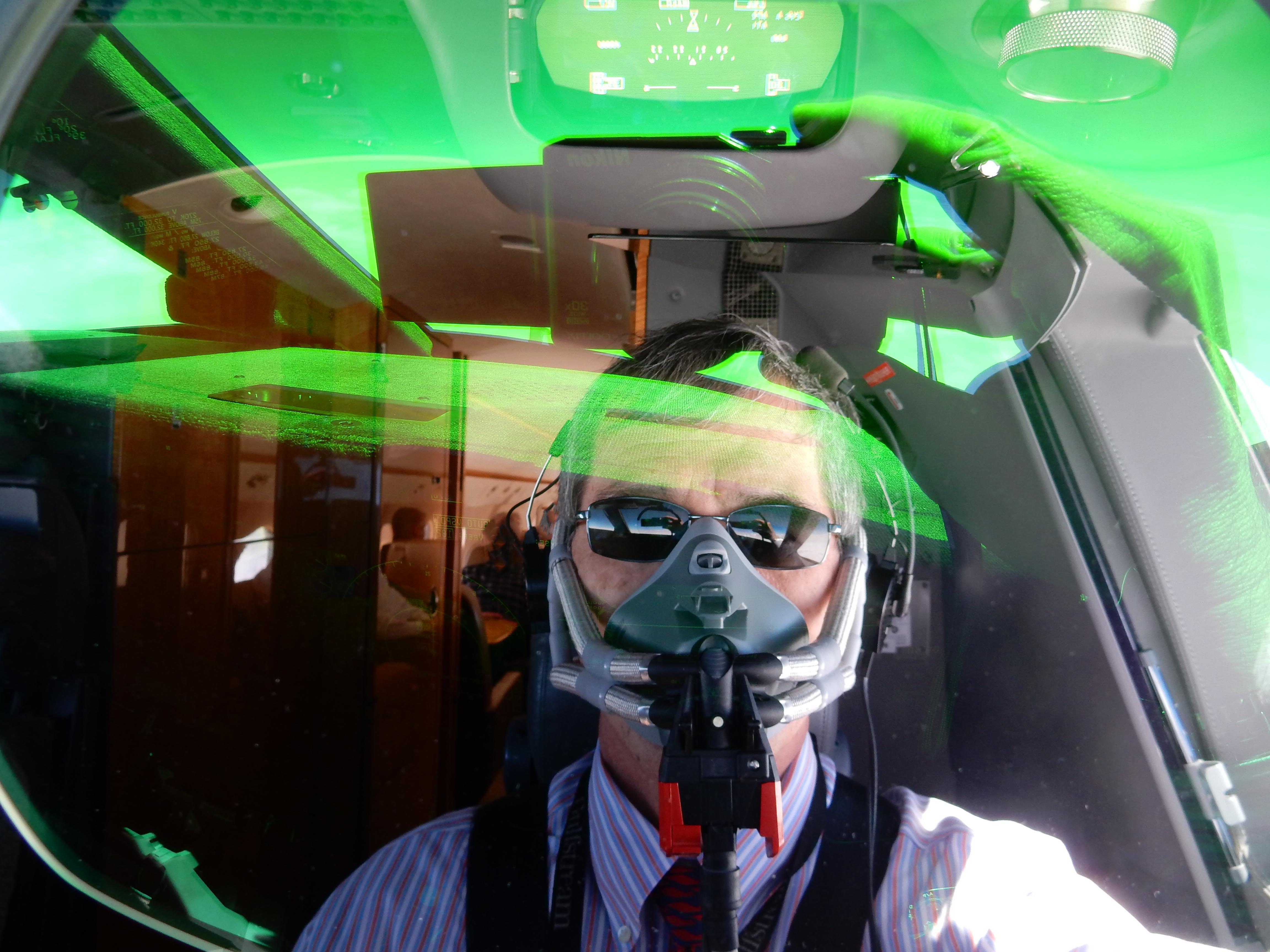I've had one rapid depressurization over the years — at FL 350 in a Boeing 707 — and believe all the practice in the simulator you can get comes in handy.
— James Albright

Updated:
2020-06-12
We tend to do these sim exercises as a chore but there are things we need to consider:
1 — Atmospheric composition and pressure
3 — Time of Useful Consciousness (TUC)

1
Atmospheric composition and pressure
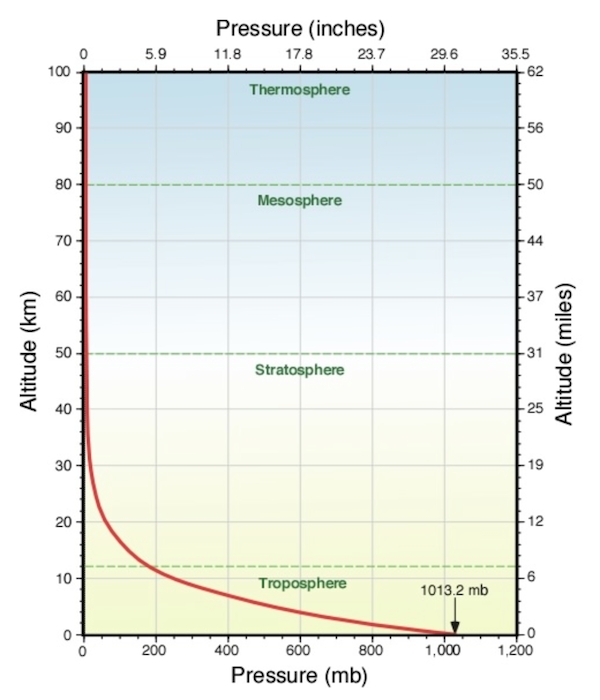
Change in average atmospheric pressure with altitude, from PhysicalGeography.net, figure 7d-1.
- Nitrogen and oxygen are the main components of the atmosphere by volume. Together these two gases make up approximately 99% of the dry atmosphere. Both of these gases have very important associations with life. Nitrogen is removed from the atmosphere and deposited at the Earth's surface mainly by specialized nitrogen fixing bacteria, and by way of lightning through precipitation. The addition of this nitrogen to the Earth's surface soils and various water bodies supplies much needed nutrition for plant growth. Nitrogen returns to the atmosphere primarily through biomass combustion and denitrification. Oxygen is exchanged between the atmosphere and life through the processes of photosynthesis and respiration. Photosynthesis produces oxygen when carbon dioxide and water are chemically converted into glucose with the help of sunlight. Respiration is a the opposite process of photosynthesis. In respiration, oxygen is combined with glucose to chemically release energy for metabolism. The products of this reaction are water and carbon dioxide.
- Air is a tangible material substance and as a result has mass. Any object with mass is influenced by the universal force known as gravity. Newton's Law of Universal Gravitation states: any two objects separated in space are attracted to each other by a force proportional to the product of their masses and inversely proportional to the square of the distance between them. On the Earth, gravity can also be expressed as a force of acceleration of about 9.8 meters per second per second. As a result of this force, the speed of any object falling towards the surface of the Earth accelerates (1st second - 9.8 meters per second, 2nd second - 19.6 meters per second, 3rd second - 29.4 meters per second, and so on.) until terminal velocity is attained.
- Gravity shapes and influences all atmospheric processes. It causes the density and pressure of air to decrease exponentially as one moves away from the surface of the Earth. [The figure] models the average change in air pressure with height above the Earth's surface. In this graph, air pressure at the surface is illustrated as being approximately 1013 millibars (mb) or 1 kilogram per square centimeter of surface area.
Source: PhysicalGeography.net
The atmosphere is 79% nitrogen, 21% oxygen, and a bunch of other things in very small quantities. The percentages are pretty much constant with altitude and don’t really matter at all . . . what matters is pressure.
By the time you get to 18,000 feet, the atmospheric pressure is one-half what it is at sea level. By 35,000 feet, you are at one-quarter pressure.
2
Cabin pressure
Most passenger carrying aircraft are pressurized to keep their cabins well below these altitudes. A typical airliner will have a cabin pressure below 8,000 feet, because that is the 14 CFR 25.841 requirement. Most large cabin corporate aircraft shoot for 6,000 feet or less.
- General. No person may operate a civil aircraft of U.S. registry—
- At cabin pressure altitudes above 12,500 feet (MSL) up to and including 14,000 feet (MSL) unless the required minimum flight crew is provided with and uses supplemental oxygen for that part of the flight at those altitudes that is of more than 30 minutes duration;
- At cabin pressure altitudes above 14,000 feet (MSL) unless the required minimum flight crew is provided with and uses supplemental oxygen during the entire flight time at those altitudes; and
- At cabin pressure altitudes above 15,000 feet (MSL) unless each occupant of the aircraft is provided with supplemental oxygen.
- Pressurized cabin aircraft.
- No person may operate a civil aircraft of U.S. registry with a pressurized cabin—
- At flight altitudes above flight level 250 unless at least a 10-minute supply of supplemental oxygen, in addition to any oxygen required to satisfy paragraph (a) of this section, is available for each occupant of the aircraft for use in the event that a descent is necessitated by loss of cabin pressurization; and
- At flight altitudes above flight level 350 unless one pilot at the controls of the airplane is wearing and using an oxygen mask that is secured and sealed and that either supplies oxygen at all times or automatically supplies oxygen whenever the cabin pressure altitude of the airplane exceeds 14,000 feet (MSL), except that the one pilot need not wear and use an oxygen mask while at or below flight level 410 if there are two pilots at the controls and each pilot has a quick-donning type of oxygen mask that can be placed on the face with one hand from the ready position within 5 seconds, supplying oxygen and properly secured and sealed.
- Notwithstanding paragraph (b)(1)(ii) of this section, if for any reason at any time it is necessary for one pilot to leave the controls of the aircraft when operating at flight altitudes above flight level 350, the remaining pilot at the controls shall put on and use an oxygen mask until the other pilot has returned to that crewmember's station.
Source: 14 CFR 91, §91.211
If an aircraft spends more than 30 minutes above 12,500' or any time above 15,000', each occupant must have supplemental oxygen or the aircraft must be pressurized.
Pressurized cabins and compartments to be occupied must be equipped to provide a cabin pressure altitude of not more than 8,000 feet at the maximum operating altitude of the airplane under normal operating conditions.
- If certification for operation above 25,000 feet is requested, the airplane must be designed so that occupants will not be exposed to cabin pressure altitudes in excess of 15,000 feet after any probable failure condition in the pressurization system.
- The airplane must be designed so that occupants will not be exposed to a cabin pressure altitude that exceeds the following after decompression from any failure condition not shown to be extremely improbable:
- Twenty-five thousand (25,000) feet for more than 2 minutes; or
- Forty thousand (40,000) feet for any duration.
Source: 14 CFR 25, §25.841(a)
This seems fairly cut and dried but it isn't. As aircraft performance increases, the economic advantages of high altitude flight start to outweigh a risk that is seen as decreasing. Certification authorities do often grant exemptions to these requirements. The Gulfstream GVII, for example, is allowed to exceed 40,000 feet cabin pressure altitude for a minute and 25,000 feet for three.
3
Time of Useful Consciousness (TUC)
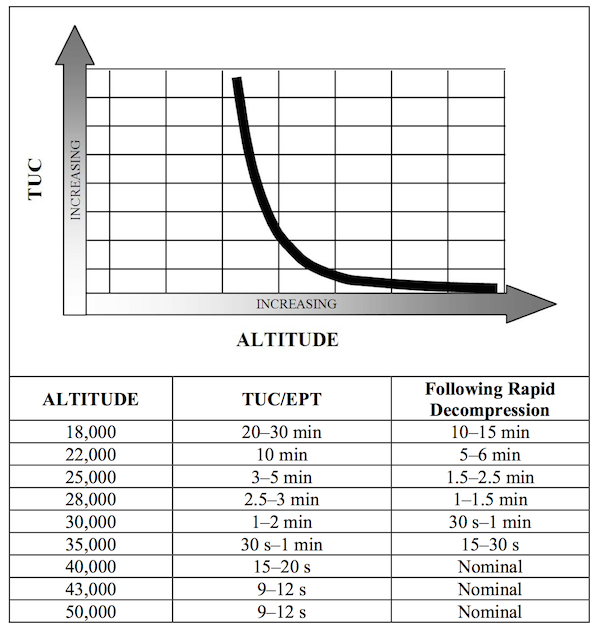
Times of useful consciousness versus altitude, from AC 61-107B, figure 2-3.
- Time of Useful Consciousness (TUC) or Effective Performance Time (EPT). This is the period of time from interruption of the oxygen supply, or exposure to an oxygen-poor environment, to the time when an individual is no longer capable of taking proper corrective and protective action. The faster the rate of ascent, the worse the impairment and the faster it happens. TUC also decreases with increasing altitude. [The figure], Times of Useful Consciousness versus Altitude, shows the trend of TUC as a function of altitude. However, slow decompression is as dangerous as or more dangerous than a rapid decompression. By its nature, a rapid decompression commands attention. In contrast, a slow decompression may go unnoticed and the resultant hypoxia may be unrecognized by the pilot.
WARNING: Slow decompression is as dangerous as or more dangerous than a rapid or explosive decompression.
WARNING: The TUC does not mean the onset of unconsciousness. Impaired performance may be immediate. Prompt use of 100 percent oxygen is critical.
Source: AC 61-107B, ¶2-7.e.(3)
In the early fifties the United States Air Force subjected a group of highly fit, young test pilots to decompression tests in an altitude chamber and came up with what everyone now relies on to determine times of useful consciousness. These times are for an individual at rest, expecting the decompression. Any exercise or fatigue will reduce the time considerably. A rapid decompression can reduce the TUC by up to 50 percent caused by the forced exhalation of the lungs during decompression and the extremely rapid rate of ascent. What's this mean to us? Few of us can expect to last as long as the table would lead us to believe.
4
Oxygen masks
Regulators and masks work on continuous flow, diluter demand, or pressure demand systems.
- Continuous Flow System. The continuous flow system supplies oxygen at a rate that may be controlled automatically or by the user. The mask is designed so the oxygen can be diluted with ambient air by allowing the user to exhale around the facepiece, and comes with a rebreather bag, which allows the individual to reuse part of the exhaled oxygen. Pilot masks sometimes allow greater oxygen flow than passengers' masks, so it is important that pilots use the masks indicated for them. Although certificated up to 41,000 ft MSL, system capabilities require very careful attention when using continuous flow oxygen systems above 25,000 ft MSL.
- Diluter Demand and Pressure Demand Systems. Diluter demand and pressure demand systems supply oxygen only when the user inhales through the mask. An automix lever allows the regulators to automatically mix cabin air and oxygen or supply 100 percent oxygen, depending on the altitude. The demand mask provides a tight seal over the face to prevent dilution with outside air and can be used safely up to 40,000 ft MSL. Pilots who fly at those altitudes should not have beards and mustaches because air can easily seep in through the border of the mask. Pressure demand regulators also create airtight and oxygen-tight seals, but they also provide a positive pressure application of oxygen to the mask facepiece, which allows the user's lungs to be pressurized with oxygen. This feature makes pressure demand regulators safe at altitudes above 40,000 ft MSL.
Source: AC 61-107B, ¶2-9.b.(1)
The pilot masks on most Gulfstream aircraft are certified to a cabin altitude of forty thousand feet and will automatically switch to positive pressurized flow if the cabin altitude exceeds thirty-five thousand feet. Of course the mask will work up to the airplane’s ceiling, but it is only certified to 40,000' and every Gulfstream since the GII has been certified to 45,000' or higher. What gives? Read on...
5
Time to descend
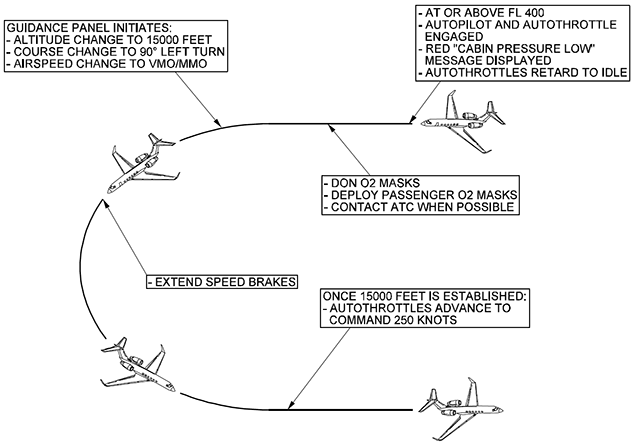
GV Emergency descent, from GV Aircraft Operating Manual, §06-04-00, figure 1.
As we've seen in our discussion above under Cabin Pressurization, the so-called “4 minute rule” doesn’t exist, at least not to say you have to complete the emergency descent in four minutes or less. If you dig deep, however, you can find four minutes as a criteria:
When the airplane is operating at flight altitudes above 10,000 feet, the following supply of oxygen must be provided for the use of passenger cabin occupants:
- When an airplane certificated to operate at flight altitudes up to and including flight level 250, can at any point along the route to be flown, descend safely to a flight altitude of 14,000 feet or less within four minutes, oxygen must be available at the rate prescribed by this part for a 30-minute period for at least 10 percent of the passenger cabin occupants.
- When an airplane is operated at flight altitudes up to and including flight level 250 and cannot descend safely to a flight altitude of 14,000 feet within four minutes, or when an airplane is operated at flight altitudes above flight level 250, oxygen must be available at the rate prescribed by this part for not less than 10 percent of the passenger cabin occupants for the entire flight after cabin depressurization, at cabin pressure altitudes above 10,000 feet up to and including 14,000 feet and, as applicable, to allow compliance with §121.329(c) (2) and (3), except that there must be not less than a 10-minute supply for the passenger cabin occupants.
Source: 14 CFR 121, §121.333(e)
No person may operate a pressurized aircraft—
- At altitudes above 25,000 feet MSL, unless at least a 10-minute supply of supplemental oxygen is available for each occupant of the aircraft, other than the pilots, for use when a descent is necessary due to loss of cabin pressurization; and
- Unless it is equipped with enough oxygen dispensers and oxygen to comply with paragraph (a) of this section whenever the cabin pressure altitude exceeds 10,000 feet MSL and, if the cabin pressurization fails, to comply with §135.89 (a) or to provide a 2-hour supply for each pilot, whichever is greater, and to supply when flying—
- At altitudes above 10,000 feet through 15,000 feet MSL, oxygen to at least 10 percent of the occupants of the aircraft, other than the pilots, for that part of the flight at those altitudes that is of more than 30 minutes duration; and
- Above 15,000 feet MSL, oxygen to each occupant of the aircraft, other than the pilots, for one hour unless, at all times during flight above that altitude, the aircraft can safely descend to 15,000 feet MSL within four minutes, in which case only a 30-minute supply is required.
Source: 14 CFR 135, §135.157(b)
It is a technical point here, but just to be clear: if you don't have enough oxygen on the aircraft for at least 10 percent of the occupants for the times listed, you need to be able to descend to 14,000 or 15,000 feet (depending on 14 CFR part) in four minutes or less. Part 91? No rule specified.
Reading between the lines, a GV is certified to fly at 51,000' with masks certified to 40,000' because Gulfstream believes the aircraft will never find itself at a cabin altitude above 40,000 feet.
6
When can you come off oxygen?
The answer appears to be 10,000 or 12,500 feet cabin altitude, depending on how you read the regulations and where in the world you are.
U.S.
(a) General. No person may operate a civil aircraft of U.S. registry—
(1) At cabin pressure altitudes above 12,500 feet (MSL) up to and including 14,000 feet (MSL) unless the required minimum flight crew is provided with and uses supplemental oxygen for that part of the flight at those altitudes that is of more than 30 minutes duration;
(2) At cabin pressure altitudes above 14,000 feet (MSL) unless the required minimum flight crew is provided with and uses supplemental oxygen during the entire flight time at those altitudes; and
(3) At cabin pressure altitudes above 15,000 feet (MSL) unless each occupant of the aircraft is provided with supplemental oxygen.
Source: 14 CFR 91 §91.211 Supplemental oxygen.
ICAO
3.4.3.6.1. A flight to be operated at flight altitudes at which the atmospheric pressure in personnel compartments will be less than 700 hPa shall not be commenced unless sufficient stored breathing oxygen is carried to supply:
a) all crew members and 10 per cent of the passengers for any period in excess of 30 minutes that the pressure in compartments occupied by them will be between 700 hPa and 620 hPa.
Source: ICAO Annex 6 Chapter 3.4
There is no ICAO requirement to use oxygen under normal circumstances. The altitudes are similar to U.S. requirements:
- 376 hPa = 25,000'
- 620 hPa = 13,000'
- 700 hPa = 10,000'
Some aircraft manufacturers (like Boeing) stipulate that exact number, removing all doubt.
After Level Off: Recheck the pressurization system and evaluate the situation. Do not remove the crew oxygen masks if cabin altitude remains above 10,000 feet.
Source: Boeing 737NG Flight Crew Training Manual, pp. 7.5 - 7.7, Rapid Descent
A sampling of some business jet manuals show very few specify an altitude. The Bombardier BD-700, Cessna Citation, and Dassault DA-900 manuals, for example, don't mention oxygen masks at all once the rapid descent is begun. The Challenger 605 Operating Manual says oxygen masks are "as required" at a "safe altitude." While most Gulfstream manuals do require oxygen be used under "High Airport Elevation" procedures, no procedure is listed for removal of oxygen masks after a rapid descent.
7
An example (G450)
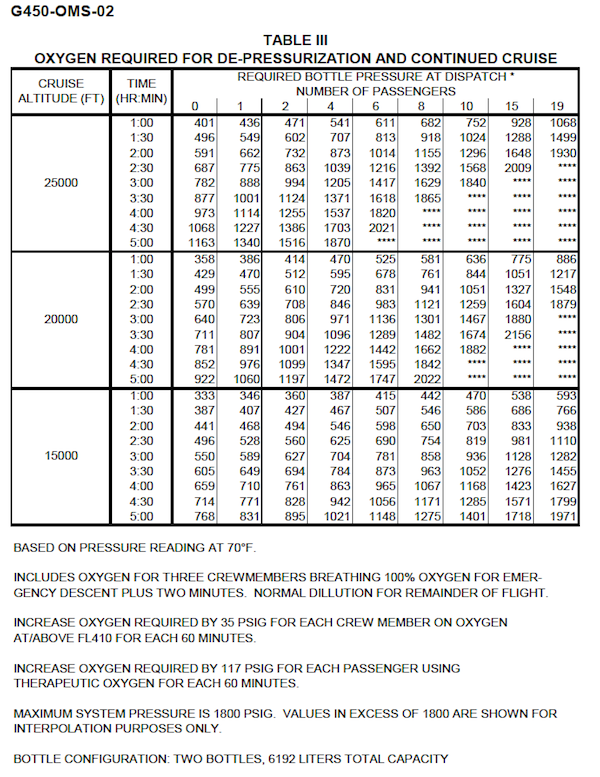
G450 Oxygen durations, from G450 OMS-02, table iii.
So you've lost all pressurization in the G450, do you have enough oxygen for everyone on board? In a word: no. As a general rule of thumb, you have more oxygen than fuel for the pilots, you have more fuel than oxygen for the passengers. You are going to need to descend to altitude where the passengers can breathe without a mask.
References
(Source material)
14 CFR 25, Title 14: Aeronautics and Space, Airworthiness Standards: Transport Category Airplanes, Federal Aviation Administration, Department of Transportation
14 CFR 91, Title 14: Aeronautics and Space, General Operating and Flight Rules, Federal Aviation Administration, Department of Transportation
14 CFR 121, Title 14: Aeronautics and Space, Operating Requirements: Domestic, Flag, and Supplemental Operations, Federal Aviation Administration, Department of Transportation
14 CFR 135, Title 14: Aeronautics and Space, Operating Requirements: Commuter and On Demand Operations and Rules Governing Persons on Board Such Aircraft, Federal Aviation Administration, Department of Transportation
Advisory Circular 61-107B, Aircraft Operations at Altitudes Above 25,000 Feet Mean Sea Level or Mach Numbers Greater than .75, Change 1, 9/9/15, U.S. Department of Transportation
Boeing 737 NG Flight Crew Training Manual, Revision 12, June 30, 2013
Gulfstream G450 Operating Manual Supplement, G-450-OMS-02, Extended Operations (ETOPS) Guide, Revision 2, April 2, 2009
ICAO Annex 6 - Operation of Aircraft - Part 2 General Aviation, International Standards and Recommended Practices, Annex 6 to the Convention on International Civil Aviation, Part II, July 2008
Please note: Gulfstream Aerospace Corporation has no affiliation or connection whatsoever with this website, and Gulfstream does not review, endorse, or approve any of the content included on the site. As a result, Gulfstream is not responsible or liable for your use of any materials or information obtained from this site.
